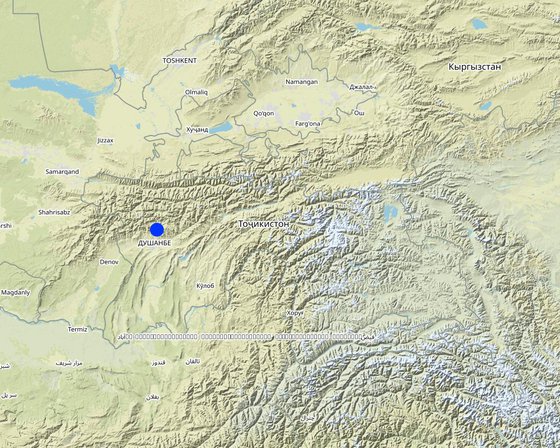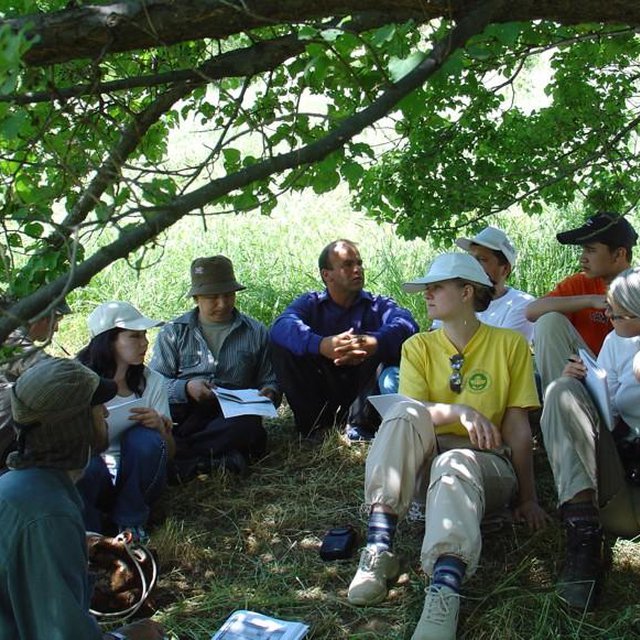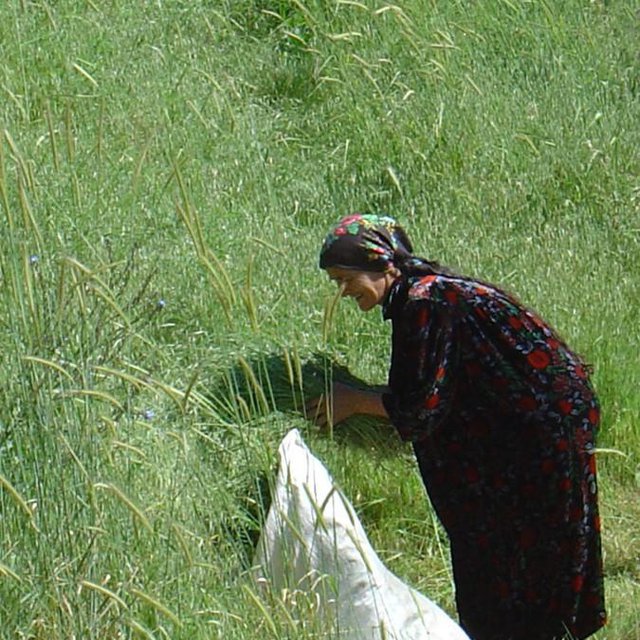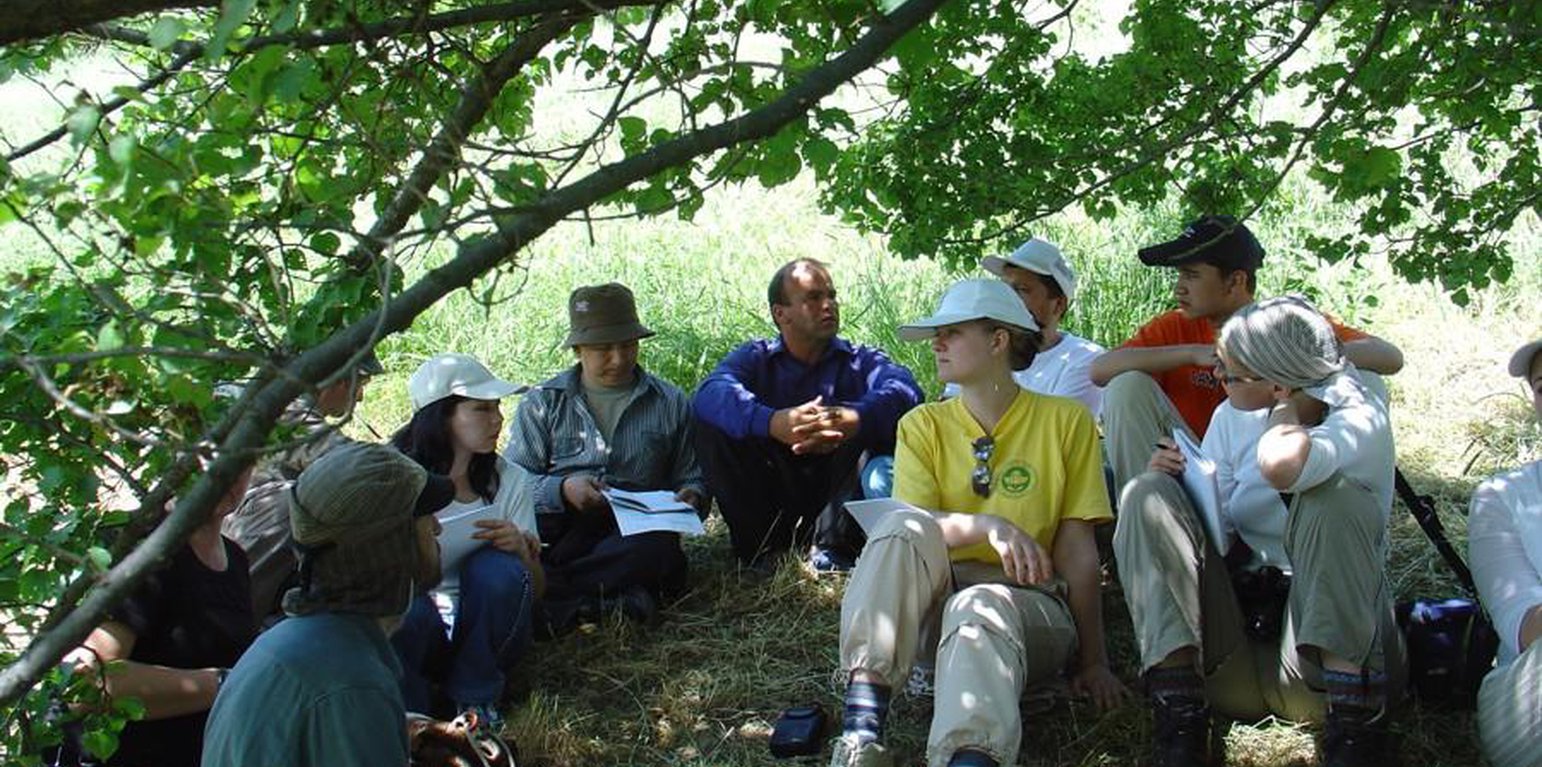Farmer innovation and self-help group
(ทาจิกิสถาน)
คำอธิบาย
An innovative land user, assisted by a self-help group has overcome many administrative and technical problems to establish a fruit garden on previously degraded communal grazing land.
Aims / objectives: Although in the 1980s the soviet government supported the establishment of private gardens in specified areas, the lack of irrigation water and suitable land often restricted this process. That was the case for Khagatai village, situated on the narrow valley floor of the Varzob River, below steep loess slopes. This marginal area is used for grazing and shows severe signs of water erosion; the hillsides are considered to be of little agricultural value. In the early 1980s, widespread unemployment evidently had the effect of stimulating people to use their own initiative. In 1982, one innovative farmer started to fence-off an area of half a hectare to establish a private fruit garden on the degraded grazing land. Some say that the fencing of plots for private fruit and hay production is a traditional practice - abandoned after the 1950s - but taken up again recently to re-establish rights to individual plots. The practice is widespread in the higher villages of Varzob, where the farmer noted it and decided to set up his own plot. When it came to practical implementation, despite the land user having five sons, the labour-intensive terracing was only completed thanks to the voluntary assistance of relatives and friends, a tradition locally known as 'hashar'. At first, when his initiative began to take shape on land officially owned by a state farm, no action was taken. However, the change in land management quickly showed positive productive results, and it may have been through jealousy that the people of Khagatai village then reported the case to the authorities. The watering of the garden on the unstable loess slope in the immediate vicinity of the village, and the consequent risk of landslides, was put forward as the reason for the complaint. The authorities opened an investigation and a number of newspaper articles were written about the case.
Methods: Since independent decision making was not common in the soviet states, and rapid degradation of newly irrigated lands on the loess deposits was a big issue, the case of this fruit garden attracted a lot of attention. However, when they observed the improved state of the vegetation on the plot, the authorities finally allowed the farmer to continue. In 1993 the prohibition on private cultivation of land was lifted in order to reduce problems of food shortage caused during the civil war that followed independence. It was during this time that four other land users from Khagatai village spontaneously began to imitate this practice.
สถานที่

สถานที่: Varzob, Khagatai, ทาจิกิสถาน
ตำแหน่งทางภูมิศาสตร์ของสถานที่ที่ถูกเลือ
วันที่ริเริ่ม: 1982
ปีที่สิ้นสุด: n.a.
ประเภทของแนวทาง
-
แบบดั้งเดิม/ แบบพื้นเมิอง
-
เป็นนวัตกรรมท้องถิ่นล่าสุด/ นวัตกรรมใหม่
-
ใช้โครงงานหรือแผนงานเป็นฐาน

The son of the innovator (centre, without hat) who manages the conserved area, discussing technical impact with researchers from the NCCR North-South Programme (see research).

Cutting grass in the fenced plot: land use was changed from open access grazing to cut and carry.
แนวทางการดำเนินการและบรรยากาศการพัฒนาที่เอื้ออํานวย
เป้าหมายหรือวัตถุประสงค์หลักของแนวทาง
To establish an orchard with grape vines, fruit trees and fodder crops for private use.
The SLM Approach addressed the following problems: The land in question is part of a communal grazing area and property rights are officially with Khagatai village (in Soviet times with a state farm). Uncontrolled grazing on communal lands has resulted in overgrazing, and thus to progressive water erosion on the steep loess deposits. No attention was paid by the local authorities to soil and water conservation measures in areas considered to be of low agricultural potential.
เงื่อนไขที่เอื้ออำนวยต่อการนำเอาเทคโนโลยีภายใต้แนวทางนี้ไปปฏิบัติใช้
เงื่อนไขที่เป็นอุปสรรคต่อการนำเอาเทคโนโลยีภายใต้แนวทางนี้ไปปฏิบัติใช้
-
บรรทัดฐานและค่านิยมทางสังคม วัฒนธรรม ศาสนา: Jealousy of other village members, who didn't like another land user fencing off a plot in communal grazing land.
Treatment through the SLM Approach: Others became convinced after the change in land use. Newspaper articles on the case also helped to form public opinion.
-
การมีไว้ให้หรือการเข้าถึงแหล่งการเงินและบริการ: All inputs had to be provided by the land user himself.
Treatment through the SLM Approach: Creative ways were developed to provide material for fencing, for transportation of irrigation water and for access to manure.
-
การจัดตั้งระดับองค์กร: Private initiatives on state land were not encouraged under the soviet system.
Treatment through the SLM Approach: Activities tended to start on marginal land that was of little agronomic interest to state farms.
-
กรอบแนวทางในการดำเนินการด้านกฎหมาย (การถือครองที่ดิน สิทธิในการใช้ที่ดินและน้ำ): No individual property rights.
Treatment through the SLM Approach: In soviet times the land belonged to a state farm. Today the land belongs to Khagatai village: efforts to achieve official
-
ความรู้เกี่ยวกับ SLM การเข้าถึงการสนับสนุนด้านเทคนิค: For the establishment of the orchard irrigation water was needed. This had to be brought 200 m up a steep slope.
Treatment through the SLM Approach: Water in old inner tubes was transported to the orchard by donkey.
-
อื่นๆ: Availability of labour: Construction of terraces for tree planting is very labour intensive.
Treatment through the SLM Approach: Voluntary work of relatives and friends.
การมีส่วนร่วมและบทบาทของผู้มีส่วนได้เสีย
ผู้มีส่วนได้เสียที่เกี่ยวข้องในแนวทางนี้และบทบาท
| ผู้มีส่วนได้เสียหรือองค์กรที่นำไปปฏิบัติใช้มีส่วนเกี่ยวข้องกับแนวทางนี้อย่างไร |
ระบุผู้มีส่วนได้ส่วนเสีย |
อธิบายบทบาทของผู้มีส่วนได้ส่วนเสีย |
| ผู้ใช้ที่ดินระดับท้องถิ่นหรือชุมชนระดับท้องถิ่น |
Mainly men participated: Women are not usually expected to carry out field activities for cultural reasons. The coffee harvest is the only activity where men and women work together in the field. |
|
การเกี่ยวข้องของผู้ใช้ที่ดินระดับท้องถิ่นหรือชุมชนระดับท้องถิ่นในช่วงต่าง ๆ ของแนวทาง
ไม่มี
ไม่ลงมือ
จ่ายเงินหรือสนับสนุนจากภายนอก
ปฏิสัมพันธ์
ระดมกำลังด้วยตนเอง
การริเริ่มหรือการจูงใจ
individual land user; the initiative was initiated by an individual land user
การดำเนินการ
land user; the project was implemented by the individual land user, relatives and neighbours participated voluntarily in terrace construction
การติดตามตรวจสอบหรือการประเมินผล
by the individual land user; the project is monitored and evaluated by the individual land user
Research
post-implementation documentation (participatory)
การตัดสินใจในการเลือกใช้เทคโนโลยี SLM
การตัดสินใจถูกทำโดย
-
ผู้ใช้ที่ดินเพียงผู้เดียว ( ริเริ่มด้วยตัวเอง)
-
ผู้ใช้ที่ดินเป็นผู้ตัดสินใจหลัก โดยการสนับสนุนจากผู้เชี่ยวชาญ SLM
-
ผู้ลงมือปฏิบัติที่เกี่ยวข้องทั้งหมดในฐานะที่เป็นส่วนรวมของแนวทาง
-
ผู้เชี่ยวชาญ SLM เป็นผู้ตัดสินใจหลัก ที่ติดตามให้คำปรึกษากับผู้ใช้ที่ดิน
-
ผู้เชี่ยวชาญ SLM เพียงผู้เดียว
-
นักการเมืองหรือผู้นำ
การตัดสินใจถูกตัดสินอยู่บนพื้นฐานของ
-
การประเมินความรู้ SLM ที่ได้ทำการบันทึกไว้เป็นอย่างดี (การใช้ข้อมูลในการตัดสินใจ)
-
สิ่งที่ค้นพบจากงานวิจัย
-
ประสบการณ์และความคิดเห็นส่วนตัว (ไม่ได้ลงบันทึกไว้)
การสนับสนุนด้านเทคนิค การสร้างขีดความสามารถ และการจัดการด้านความรู้
กิจกรรมหรือการบริการต่อจากนี้เป็นส่วนหนึ่งของแนวทาง
-
การสร้างขีดความสามารถ / การอบรม
-
การบริการให้คำแนะนำ
-
การเสริมความแข็งแกร่งให้กับสถาบัน (การพัฒนาองค์กร)
-
การติดตามตรวจสอบและประเมินผล
-
การวิจัย
การบริการให้คำแนะนำ
การให้คำแนะนำถูกจัดขึ้น
-
ไปเยี่ยมชมสถานที่
-
ที่ศูนย์ถาวร
-
through interaction of land users
Key elements: Observations, farmer-to-farmer exchange of ideas.
การติดตามตรวจสอบและประเมินผล
Bio-physical aspects were ad hoc monitored by land users through observations; indicators: growth of seedlings
Economic / production aspects were ad hoc monitored by 0 through observations; indicators: comparison of yields between different years
no. of land users involved aspects were ad hoc monitored by 0 through observations; indicators: None
There were few changes in the Approach as a result of monitoring and evaluation: There were a few changes due to the observations made by the land user: he started to apply supplementary irrigation to the tree seedlings, as well as applying manure each year.
การวิจัย
การวิจัยกระทำกับหัวข้อต่อไปนี้
-
สังคมวิทยา
-
เศรษฐศาสตร์หรือการตลาด
-
นิเวศวิทยา
-
เทคโนโลยี
There had been no research until the identification and documentation of this initiative through a Tajik-Swiss project under the framework of the National Centre of Competence in Research (NCCR) North-South (coordinated by the the Centre for Development and Environment, Switzerland).
การสนับสนุนด้านการเงินและวัสดุอุปกรณ์
งบประมาณประจำปีสำหรับองค์ประกอบ SLM เป็นจำนวนดอลลาร์สหรัฐ
-
< 2,000
-
2,000-10,000
-
10,000-100,000
-
10,000-100,000
-
> 1,000,000
Precise annual budget: n.a.
Approach costs were met by the following donors: other (land user/private): 100.0%
การบริการหรือแรงจูงใจต่อจากนี้ได้ถูกจัดให้สำหรับผู้ใช้ที่ดิน
-
การสนับสนุนด้านการเงิน / วัสดุอุปกรณ์ให้แก่ผู้ใช้ที่ดิน
-
เงินสนับสนุนสำหรับปัจจัยการผลิต
-
เครดิต
-
แรงจูงใจหรือเครื่องมืออื่น ๆ
ผลกระทบและสรุปคำบอกกล่าว
ผลกระทบของแนวทาง
ไม่ใช่
ใช่ เล็กน้อย
ใช่ ปานกลาง
ใช่ อย่างมาก
ช่วยให้ผู้ใช้ที่ดินนำเอาเทคโนโลยี SLMไปใช้และบำรุงรักษาสภาพไว้ได้หรือไม่
There has been a significant, though localised, improvement in soil and water management.
ทำให้กลุ่มด้อยโอกาสมีอำนาจทางสังคมและเศรษฐกิจหรือไม่
Did other land users / projects adopt the Approach?
Other land users from Khagatai village have adopted the system on the same hillside. They started fencing-off plots in the 1990s during the civil war. At that time many people were unemployed, and labour was therefore available. Furthermore there was a shortage in food supplies and people relied on .
It was very unusual during the soviet times for a villager to take the initiative to establish a private plot on state land. However in this example, the success in establishing a vineyard on an overgrazed hill convinced the administration of its worth. Other land users have now followed this approach.
แรงจูงใจหลักของผู้ใช้ที่ดินเพื่อที่จะนำ SLM ไปปฏิบัติใช้
-
การผลิตที่เพิ่มขึ้น
-
กำไร (ความสามารถ) อัตราส่วนค่าใช้จ่ายต่อผลประโยชน์ที่เพิ่มขึ้น
-
การเสื่อมของที่ดินลดลง
-
ความเสี่ยงของภัยพิบัติลดลง
-
ภาระงานลดลง
-
การจ่ายเงินหรือการช่วยเหลือ
-
กฎและระเบียบ (ค่าปรับ) หรือการบังคับใช้
-
เกียรติภูมิ แรงกดดันทางสังคม ความเชื่อมแน่นทางสังคม
-
การเข้าร่วมสมทบในขบวนการ โครงการ กลุ่ม เครือข่าย
-
จิตสำนึกด้านสิ่งแวดล้อม
-
ประเพณีและความเชื่อ ศีลธรรม
-
ความรู้และทักษะ SLM ที่เพิ่มพูนขึ้น
-
การปรับปรุงด้านสุทรียภาพ
-
การบรรเทาด้านความขัดแย้ง
-
well-being and livelihoods improvement
ความยั่งยืนของกิจกรรมของแนวทาง
ผู้ใช้ปที่ดินสามารถทำให้สิ่งต่างๆ ที่ได้ปฏิบัติใช้โดยแนวทางนี้ยั่งยืนได้หรือไม่ (โดยไม่มีการสนับสนุนจากภายนอก)?
Because this approach is based on local initiatives there is no reason why it should not be sustainable. The insecure land use rights are the only potential risk to the continuation of the activities.
บทสรุปหรือบทเรียนที่ได้รับ
จุดแข็ง: มุมมองของผู้ใช้ที่ดิน
-
Rehabilitation of marginal land for production and generation of additional income. (How to sustain/ enhance this strength: Give property rights to land users to motivate further investments in soil and water conservation/production.)
จุดแข็ง: ทัศนคติของผู้รวบรวมหรือวิทยากรคนอื่นๆ
-
Bottom-up approach: independent decision making by the individual land user based on dynamic and flexible responses as required. (How to sustain/ enhance this strength: Give property rights to land users to motivate further investments in soil and water conservation/production.)
จุดด้อย/ข้อเสีย/ความเสี่ยง: มุมมองของผู้ใช้ที่ดินแก้ไขปัญหาได้อย่างไร
จุดด้อย/ข้อเสีย/ความเสี่ยง: ทัศนคติของผู้รวบรวมหรือวิทยากรคนอื่นๆแก้ไขปัญหาได้อย่างไร
-
Current systems of land ownership, currently the land belongs to Khagatai.
Provide land ownership to the farmers.
-
Not all farmers can apply this technology since it is location specific.
Identify if fodder production (cut-and-carry) would be more attractive than open grazing; allocate land to the farmers.
-
Only families with sufficient labour resources can establish such a garden by themselves.
Incentives from the state or other organisations are needed.
-
Since it is an initiative of an individual land user, the SWC technology has not been documented so far, nor evaluated, and lessons learned have not been spread among the land users.
Documentation and spreading of lessons learned.
การอ้างอิง
ผู้ตรวจสอบ
-
David Streiff
-
Alexandra Gavilano
-
Deborah Niggli
-
Joana Eichenberger
วันที่จัดทำเอกสาร: 13 มกราคม 2009
การอัพเดทล่าสุด: 2 พฤศจิกายน 2021
วิทยากร
-
Murod Ergashev (soil_m@rambler.ru) - ผู้เชี่ยวชาญ SLM
-
Sharif Aliev family - ผู้ใช้ที่ดิน
คำอธิบายฉบับเต็มในฐานข้อมูล WOCAT
การจัดทำเอกสารถูกทำโดย
องค์กร
- CAMP - Central Asian Mountain Partnership (CAMP - Central Asian Mountain Partnership) - คีร์กีซสถาน
โครงการ
- Book project: where the land is greener - Case Studies and Analysis of Soil and Water Conservation Initiatives Worldwide (where the land is greener)
- Pilot Program for Climate Resilience, Tajikistan (WB / PPCR)






